“The Seven Ranges of Toxicity of American Empire: Inspection, then Infection, Invasion, then Extermination, Exploitation, then Exhilaration, and ultimately Exoneration.”
[TCDD at the POB: Tetra – Chloro – Dibenzo – Dioxin at the Point of Beginning.]
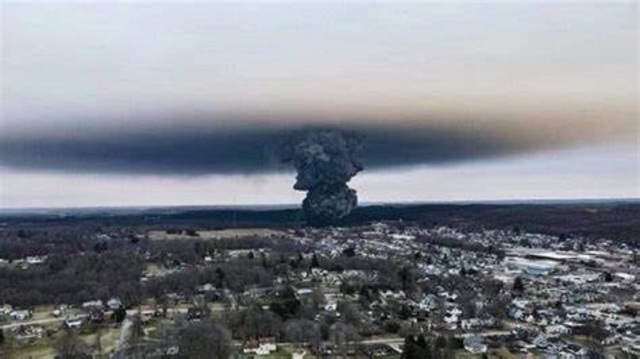
– Grand Theft World – Liberty Radio News – March 19, 2776 Ad Urbe Condita -_Dedicated to the inspiring, Dr. Gerald Horne, PhD._
CHAPTER ONE – INSPECTION
-Beginning at the endpoint, near old Tuscawaras (Bolivar, Ohio)
.

The Delaware native tribe established river town, Tuscawaras, now called Bolivar, was the military center of operations for defense of the native held lands of the Ohio Country that so terrified the land surveyor chosen and commisioned in 1785 to map and allot them into seven ranges by the United States Government, Mr. Thomas Hutchins, a New Jersey-born orphan, who upon teenage enlistment, was immediately posted to the forks of the Ohio River itself in 1763. His initial reconnaissance and inspections of the Ohio Valley were artistically diagrammed in numerous maps which established his reputation as an expert leading geographer of the area.

Thus selected to lead the survey party, and after having extended the 1767 Mason and Dixon surveyed line of Pennsylvania with Maryland and Virginia from Brown’s ridge to the SW corner in 1784 with Virginia State Commissioners, Hutchins would return there in 1785, to measure and mark the border of Virginia (now West Virginia) and Pennsylvania, due North to the Ohio River and across to the far bank, where a wooden stake was driven, in order to finally begin the first U.S. public land survey, and for the traverse due west to proceed. Hutchins and his survey field crew then made camp just below the mouth of Little Beaver Creek thereupon the north bank of the Ohio River, some forty miles below its source at the forks in Pittsburgh, PA. Completing the open traverse of the Seven Ranges Survey by September 13, 1786. The terminus of the first western line traversed was permanently monumented by Hutchins with a large square stone with an “X” chiseled on top and a hole drilled into the center, which the author visited today on the ground.

Thus begins the story of inspection, then infection, invasion, then extermination, exploitation, then exhilaration, and ultimately exoneration: the Seven Ranges of Toxicity of American Empire.
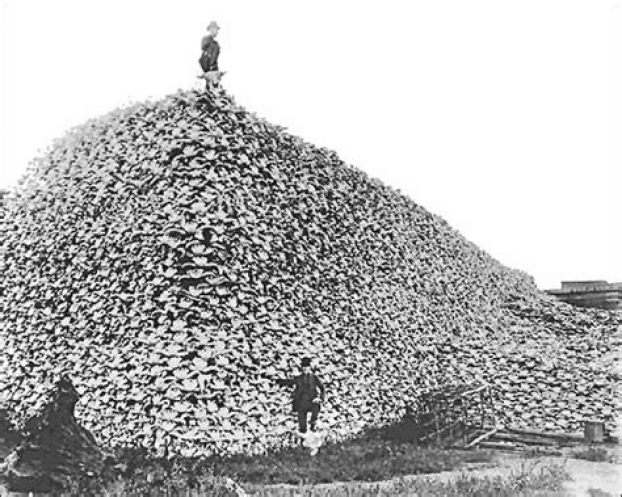
In fact, during the three long year land survey, originally expected to be completed in one year, (thus tripling the initial five thousand dollar estimated cost), Hutchins and his assistants would stop their work and flee to safety, as reports of their trespass reached the village of Tuscawaras, where defenses where being mounted. The nation’s young legislature starved for revenue and drooled at the prospect of platted lots on survey maps allowing immediate sale of native lands by the colonial government to the invading colonists. Due to the expense and time taken during the initial Hutchins survey, the young government subsequently allowed large companies to survey their own lands and then submit documents for granting of land title, out of sheer impatience and greed. Meanwhile the trespassers in Ohio Country continued to poach and pilfer native herds for pelts and antlers, leaving mounded-up stripped carcasses behind, much to the puzzlement of the natives, who were obliged to make ceremonies and rub tobacco upon such horrid discoveries. Shingas and Tamaqua had relocated their Lenape brethren to Kittaning, Pennsylvania on the Allegheny River near Pittsburgh due to expanding settlement of their Susquehanna valley homelands. Chief Shingas of the Lenape Delaware tribe repeatedly visited Fort Pitt, formerly Fort Duquesne, and now Pittsburgh, imploring for peace, and instead received soiled blankets that likely killed him.

Barely four miles were surveyed in 1785, Hutchins was not willing to travel farther west and risk running into the violent conflict with the Lenape Delaware tribe, which had sparked after a Pennsylvania militia massacred ninety six of their people. Thus the remaining thirty eight miles of what is now called, “the Geographer’s Line”, were completed in 1786, as Thomas Hutchins was officially named the Geopgrapher of the United States.

When Hutchins was initially posted under the command of Col. Henry Bouquet and Gen. Jeffrey Amherst, the orders fell to him and his platoon mates to distribute infected blankets and hankerchiefs, saturated with pestilent smallpox to the Delawares, Wyandottes, Shawnees, and other native tribes allied with Obwaandi’eyaag a/k/a Chief Pontiac against the invading colonists during the French and Indian War in 1763. The original hand written orders and correspondences between Bouquet and Amherst directly discussing extermination with biological contagion are of permanent record at the United States Library of Congress and free to download.
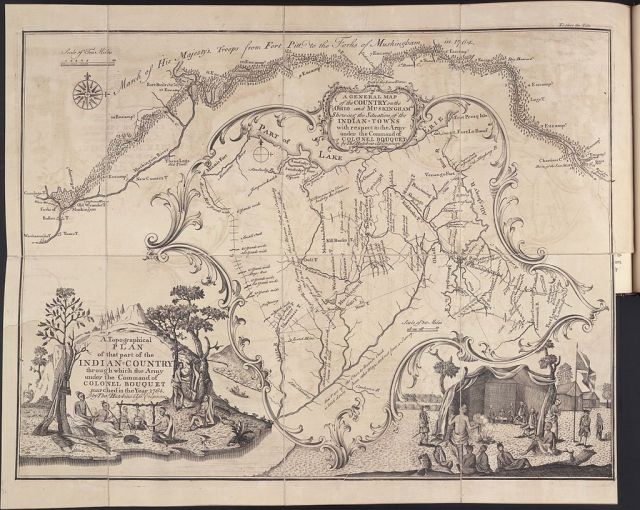
END CHAPTER ONE – INSPECTION

==============================================================
CHAPTER TWO – INFECTION
-“Use Every Stratagem In Our Power To Reduce Them.”
“Could it not be contrived to Send the Small Pox among those Disaffected Tribes of Indians? Use Every Stratagem in our power to Reduce them” letter received June 23, 1763 from Gen. Amherst by Col. Bouquet, Cmdr. of Ft. Pitt.

June 24, 1763, from the journal of William Trent:
“The Turtles Heart, a principal Warrior of the Delawares, and
Mamaltee, a Chief, came within a small distance of the Fort Mr. McKee. [We] went out to them and they made a Speech letting us know that all our [pelts] at Ligonier [were] destroyed, [and] that great numbers of Indians [were coming and] that out of regard to us, they had prevailed on the six Nations, (The Iroquoian Confederacy), [not to] attack us but give us time to go down the Country and they desired we would set off [and leave] immediately.
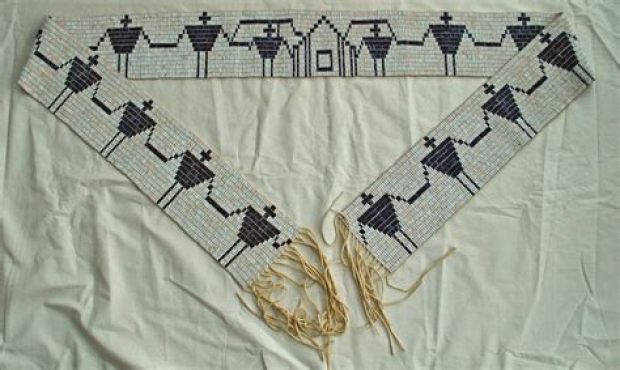
The Commanding Officer thanked them, let them know that we had everything we wanted, that we could defend it against all the Indians in the Woods, that we had three large Armys marching to Chastise those Indians that had struck us, told them to take care of their Women and Children, but not to tell any other Natives.

They said they would go a speak to their Chiefs and come and
tell us what they said, they returned and said they would hold fast of the Chain of friendship. Out of our regard to them we gave them two Blankets and a Handkerchief out of the Small Pox Hospital. I hope it will have the desired effect.”

Chemical and biological warfare made great advances with British colonization of North America. What began with Hutchins, Ecuyer, and Trent et ali, complying with orders handed down from Amherst to Bouquet, continues at the source of the Ohio River today, at the February toxic train derailment site in Ohio, with the state EPA refusing to test for Acrolein, the key marker in dioxin toxicity, and an element responsible for defoliation and aggressive cancers. For example, the two chemical herbicides: 2,4,5-T combined with 2, 4-D evenly (50/50) produce the “tactical defoliant” agent orange, which leaves long lasting toxic residues of Acrolein and TCDD, Tetra-Chloro-Dibenzo-DIOXIN.
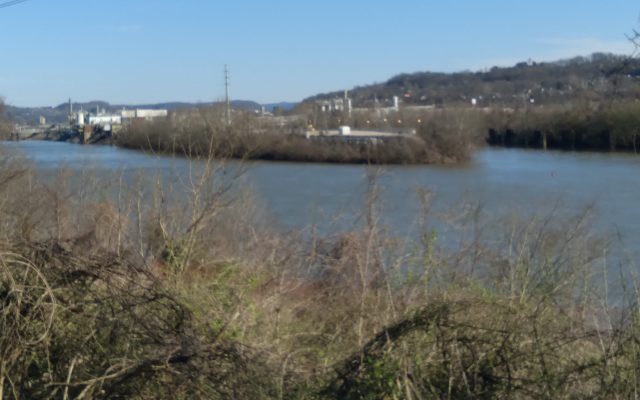
In fact, Clendenin, West Virginia on the Elk River near the Great Kanawha River would build the first petrochemical plant in human history for Union Carbide in 1921, later relocating to nearby Charleston, developing and producing agent orange, which was then used against Southeast Asia and elsewhere extensively. From the deliberate spread of smallpox to the deliberate spread of extremely carcinogenic dioxins, chemical and biological warfare trial and error still characterize the undeniably genocidal character of America’s empire for business, not people.

While the efficacy and lethality of smallpox infection via blankets and other clothing is in need of further study to draw scientific conclusions, it is indisputable, per the written record of prima facie historical documents that the intent to completely exterminate the native “vermine”, (as they were directly referred to), was vigorous and imaginative, using every “stratagem” to murder natives they said had “fully abandoned their rights to any humanity.”

Given the narrative since toxic dispersal by Norfolk Southern Railroad in East Palestine, Columbiana County Ohio, some five weeks ago, (began February 3, 2023, and ongoing), the deliberate and obnoxious cover up of ongoing crimes against humanity, only reaffirms the nature of the history of the Ohio Country since it’s initial inspection and mapping, and the spreading of infection and depopulation of the land, leading to fortifications and subsequent waves of invasion by english speaking colonists thus guarded militarily.

Unironically, the military continue to guard against the people of Ohio, with the public and prominent collusion of Governor Mike DeWine aiding The Norfolk Southern Corporation in its ongoing toxic poisoning of all forms of life in the entire Ohio Valley, and the simultaneous real-time cover-up. Most notably the commanding officer of the Ohio National Guard, Major General John Harris Jr., personally assaulted journalist, Evan Lambert, at the Governor’s presser in East Palestine and then had that reporter falsely arrested and further assaulted by the local Police. Body-camera footage showed Harris confronted and pointed a finger at Lambert and then briefly pushed the reporter with one hand in the chest. Ohio Attorney General Dave Yost, who dismissed trespassing and resisting arrest charges against the NewsNation correspondent, was asked by the county prosecutor to review the charges, and said the local officials appeared to be following the lead of the National Guard. As of this writing, General Harris has yet to be charged for assault nor relieved of his command. Invasions begin with Armies, then come the wagon trails, and the boat canals, and then the train tracks…..

END CHAPTER TWO

==============================================================
CHAPTER THREE – INVASION
-Vandalia, Charlotina, and the old Northwest –

By default, the initial expansion from the original thirteen colonies, into the country north and west of the Ohio River, which was won by the military victories of General George Rogers Clark at the french outposts there, (most notably Cahokia and Kaskaskia, and at Vincennes in today’s states of Illinois and Indiana respectively), thus necessitated immediate improvements to infrastructure, for all that existed were buffalo traces and other well worn animal paths followed by the local tribesmen, as well as an extensive waterway network easily canoed about, but somewhat prohibitive to deepwater vessels of any kind.

Thus the narrowboats were unable to ply such waters, and the first great canal project towards the old Northwest began, as Virginia would win the claim to it, and utlimately produce West Virginia, Kentucky, Ohio, Indiana, Illinois, Wisconsin, Michigan, and most of Minnesota, being all of the lands north of the Ohio River, East of the Mississippi River and south of the shores of the Great Lakes and west of the Iroquoian Confederacy of six nations. George Washington and others would contribute to the survey, design, and build of the Chesapeake and Ohio Canal, connecting the tidewater at Washington City (D.C.) and following the Potomac River up through numerous locks and dams to Cumberland, Maryland. In 1787, Washington and Jefferson both noted the need for and a canal linking the Ohio River to Lake Erie. However, such time, lives, and expense were lost to that venture, considering the Pawpaw canal tunnel in particular, that in the meantime new types of boats were made to ply the Ohio, namely keelboats and flatboats as pictured above.

And so in 1827 the Ohio and Erie Canal opened, and the following year a canal was proposed to connect this canal directly from old Tuscawaras, (renamed Bolivar), going up the Sandy Creek just beside the aforesaid terminus stone planted by Hutchins, and down the Little Beaver Creek, about seventy miles to the Ohio River. Ohio legislation chartered the Sandy and Beaver Canal in 1828.
Requiring two tunnels, thirty dams, ninety locks, three reservoirs, and an aqueduct before its completion proved virtually impossible. Due to the middle section, the canal experienced numerous wash outs and levee failures. Although both eastern and western sections were heavily used by local farms and trade, travel along the entire length of the canal was never possible despite completion in 1848. Less than four years later the Cleveland and Pittsburgh Railroad was completed, removing the boat traffic which prompted its immediate abandonment despite such spectacular infrastructure design and construction.
Nevertheless, the Geographer’s lines endpoints had been joined with a navigable channel, however brief. With river navigation in addition to crude wagon trails for “shake-guts” stagecoaches to attempt, waves of settlement proceeded, and cabins and small clearings took hold, making permanent the trespass into what was proposed as a new nation of Charlotina, but never came to pass. With the same spirit, the colony of Vandalia, in honor of the same Queen Charlotte was proposed adjoining the ol’ Northwest, primarily what is today’s West Virginia, but along with Charlotina, and the area’s old history, has gone forgotten.
This American invasion was to annex more American territory, not establish new nations, much less recognize the existing ones. At this stage, settlers and traders were the cutting edge, hacking into the wild brush of the wilderness, dragging quarry to boat and horseback. George Stephenson’s innovation of the iron tracked tram way coupled with Fulton’s steam engine, allowed the new railroading technology to fully exploit at accelerating pace, the natural resources of North America, and for complete extermination to be pursued at full steam.
END CHAPTER THREE

==============================================================
CHAPTER FOUR – EXTERMINATION
-“The locality on the Ohio River where the struggle occurred is in Virginia (now Newell, West Virginia), almost opposite to the mouth of Little Yellow Creek.” -Sarah Poe-Kuffel, daughter of Adam Poe.

The extermination of first nations tribes across the Ohio Valley is seldom mentioned yet followed upon the depopulation of the east coast, which began in earnest with the Mayflower party and Virginia party arrivals at Massachusetts Bay and Chesapeake Bay respectively. With independence declared, and settlers bounding through the Ohio Valley, wholesale genocide was encouraged and prosecuted across the old Northwest, expelling the few that survived to the Illinois Confederacy, as Cherokee and Creek tribesmen fled south and dug in, some indeed joining with the Seminole taking cover in the swampy gulf lands. The Cherokee capital was moved from Chota, TN to New Echota down near Dalton, Georgia as well.
Then came the great german wave of immgrants, among those leading this raging tide, The Poe brothers were descendants of French General De la Poer, whose sons relocated to the Palatinate of Germany, and then immgrated to the outskirts of Ohio’s East Palestine. Yona’s History Rhymes.

Shared below is the retelling of the pair’s encounter with Lenape Delaware warrior, Bigfoot, which took place around 1810 about three miles down the Ohio River from the P.O.B. beside Little Beaver Creek, in today’s Newell, West Virginia.
“The snapping of the gun alarmed the Indians, who, looking around, discovered Andrew. It was too late for him to run, and I doubt if he would have retreated if he could, for he was a great wrestler and coveted conflict with the Indians. So he dropped his gun, and bounding from where he stood, caught both the Indians and thrust them upon the ground. Though he fell uppermost in the struggle, he found the grip of Bigfoot to be of iron, and as a consequence, the little Indian soon extricated himself and instantly seized his tomahawk and advanced with fatal purpose toward Andrew.
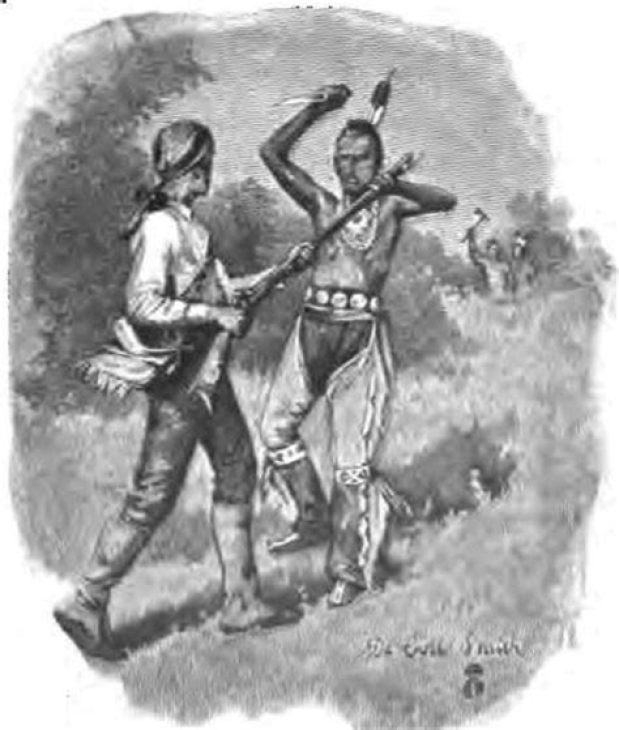
To better assist and aid the little Indian, who had the tomahawk aimed at the head of Andrew, Bigfoot hugged and held him with a giant’s grasp, but Andrew, when he struck at him, threw up his foot and kicked the tomahawk out of the little Indian’s hand. This made Bigfoot indignant at the little savage, who soon repeated his experiment with the tomahawk, indulging in numerous feints before he delivered the main blow, which Andrew parried from his head and received upon his wrist.”
Andrew Poe managed to free himself from Bigfoot, then grabbed one of the Indians’ guns and shot the little Indian. Then Poe and Bigfoot began their struggle again, both plunging into the water.
“A mutual effort was at once made to reach the shore and get possession of a gun and close the struggle with powder and lead,” Sarah Poe-Kuffel wrote. “Bigfoot was a glib swimmer and was the first to reach the bank. In this contingency Andrew wheeled about and swam further out into the river to avoid, if possible, being shot, by diving strategies. The big chief, lucklessly to him, seized the unloaded gun with which Andrew had shot the little Indian. Meantime, Adam Poe, having missed his brother and hearing a gunshot, inferred he was either killed or in a fight with the Indians and hastened toward him.

Adam now being discovered by Andrew, the latter called to the former to shoot Bigfoot. Unfortunately, Adam’s gun was empty as was the big Indian’s. The strife now was between the two as to which could load quickest, but Bigfoot in his haste drew his ramrod too violently from the gun, which accident gave Adam the advantage, when he shot Bigfoot as he was in the act of drawing his gun upon him.
So that it was my uncle Andrew that had the wrestle on the bank with Bigfoot, and the struggle with him in the river, and it was my father, Adam Poe, who shot Bigfoot when he came to shore. The wound that my father received, he got in the fight with the body of six Indians who were overtaken, five of whom were killed, with a loss of three of their pursuers and the hurt done to my father.” –SARAH POE-KUFFEL.
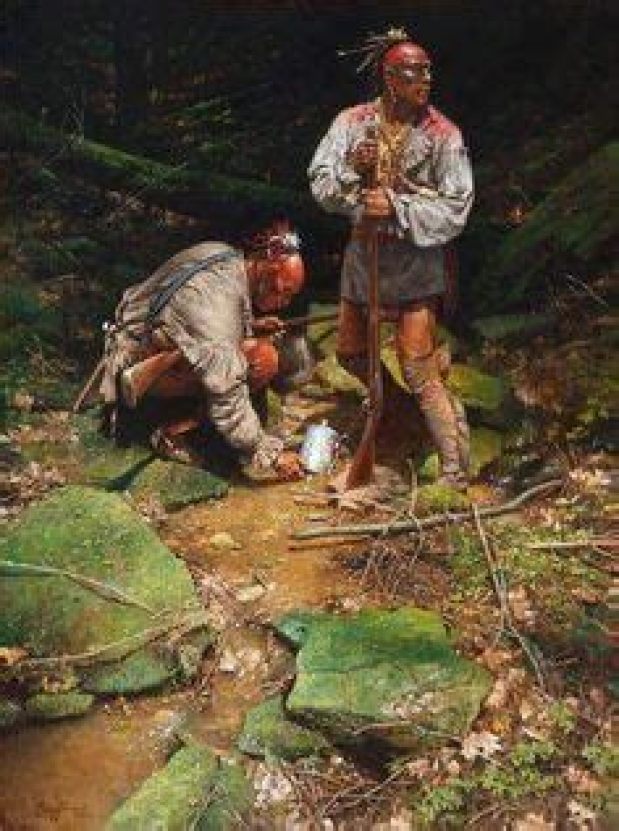
Of those that managed to survive the second great wave of genocide, that chopped and burned across the old Northwest, most survivors were deported to Kansas and the remainder would join the Cherokees and the Muskogee Creeks and the Seminoles onto to the trail of tears and their sparse remnants are yet still in Kansas and Oklahoma. At last, with indian title claims to the area “fully extinguished”, corporate exploitation, wholescale clear-cutting and mining could now proceed at the speed of steam locomotion.
END CHAPTER FOUR

CHAPTER FIVE – EXPLOITATION
–Defenseless beauty as bounty, subject to the whims and benevolence of rapists, murderers, and thieves.

Again we return below the mouth of Little Beaver Creek on the Ohio River, as Bigfoot’s lifeless body and buckskins float by in our narrative, passing the old wooden stake planted by the young orphan child soldier who gave-out smallpox blankets as so ordered. And we are joined by canal boats plying the said Little Beaver’s banks down from New Lisbon, Ohio via numerous locks, only to now see the entire Ohio valley being chained in every hollow and bottom with twin bands of iron, knotting themselves together with tremendous trestles, tunnels, big cuts and earthen fills.
Industrial exploitation advanced at a breakneck speed, coincidentally breaking the necks of many laborers in the process, and beating them and the land itself into submission with steam driven locomotives capable of exporting the timber, coal, and other valuable ores, and farm goods, faster than they could even be produced. Such improvements have been fought at every turn, privatized when possible, and often left to neglect and ruin, if not just casually abandoned, but usually receiving last-minute emergency repair barely sufficient to restore the facilities to service, be they waterways, runways, highways, or railways.

Increasing numbers of slaves fled the old Virginia country, plying the waters of the Ohio River to the north shore where the underground railroad began, leading slaves up north to Canadian freedom, safe from the reach of slave catchers and dog teams. A principal route of emancipation crossed the Ohio River via the Wheeling Suspension bridge (the first ever built over the Ohio, in 1847, opened in 1849) and led up the free side of the river to East Liverpool were several safehouses were, and have been preserved and can be toured today. The over-gorund railroads on the other hand, sought to emancipate as much wealth as possible from the bounty of earth’s beauty and treasure.

Thus the Smith’s Ferry Branch Railroad was constructed by a coal company, along the upper easterly bank of our Little Beaver Creek, beginning at its mouth near our wooden stake marking three states (PA, WV, & OH), and opposite the towpath and final discharge of the abandoned boatway of the Sandy & Beaver Canal.
The Pittsburgh Coal Company planned to ship coal from their coal mines along the Monongahela River just above Pittsburgh, to the Republic Steel Company in Youngstown, Ohio without having to use existing carriers, such as the Pennsylvania Railroad (PRR) or the Pittsburgh & Lake Erie Railroad (P&LE). Thus coal would go from the mines via the Monongahela and Ohio rivers to Smith’s Ferry, Pennsylvania, on the Ohio River at Little Beaver Creek, where it would then be transported by rail to Youngstown.
To avoid using the PRR to reach Youngstown, Pittsburgh Coal constructed a three million dollar railroad along Beaver Creek from Negley south to Smith’s Ferry, through a tunnel at Grimms Bridge. The PRR and the P&LE railroads sought to halt construction, seeing that Pittsburgh Coal would bypass their lines in favor of their own direct route. It amounted to an over two and a half million dollar revenue drop for the PRR. Operations on the new railroad began in mid-1936 with fifty to sixty carloads daily. Active service continued until 1967, for a landslide then filled the south end of the Tunnel. Abandoned thereafter, and then the old track and trestle were finally removed in 1995. The mineral and gas exploitation led to such exhilaration, with cash raked in, hand over fist, and as resources were exhausted, the canals, rails, and roads were then neglected, if not abandoned and/or entirely dismantled. Profits privatized and losses socialized. All aboard!
END CHAPTER FIVE
CHAPTER SIX – EXHILARATION
-Expanding markets and profits and irrational exuberance.
Norfolk Southern Railroad as well as the other Class One Railroads of North America (CSX, BNSF, UP, and KCS) despite earning record setting profits have in fact transformed the US rail system in less than thirty years to the worst maintained and most poorly staffed in the world, resulting in nearly two thousand derailments per year across the continental United States.
The network reached a zenith in length with over 145,000 track miles around 1920, and barely half even exists still today (75,000 miles) of which less than half is even in regular use or consistent service. Thus freight service has pulled back by at least 75 % and passenger service cut by more than 90 % due to private ownership and mismanagement. What remains of this critical infrastructure does more harm than good, when hazardous material derailments and spills are made exceedingly worse by amplifying dispersal with intentional incineration on site, and then re-incineration of recovered contanimates from East Palestine at the smokestacks in East Liverpool, the town which is home to Hutchins wooden stake at the Point of Beginning, referenced on the town’s state line monument.
Exhilaration in nearly unimaginable profits led the railroad, and the regulators on their payroll subject to their whim and desire, to hastily cover-up and toss aside the most toxic chemicals known to Earth, merely to re-open the rail section damaged by derailment in less than five days, even before residents were allowed to return after an inadequate evacuation that never should have been lifted, but expanded IMHO. Dioxins now pour into the Ohio River from Little Beaver Creek as a result at levels higher than have ever been measured before anywhere on this planet.
END CHAPTER SIX
CHAPTER SEVEN – EXONERATION
-Thence with fence to the point of beginning, euphemising with legend, not bounded by history nor acreage, more or less, and containing pollution for the heirs and the assigns, forever and ever, by survey of D.S. Yona Anzelmo. -PLS 3753KY, SMC-KY/DSCC-WV.
Immediate and unquestioned exoneration of corporate misconduct from punishment with imprisonment much less death is now the standard protocol for business regulation of the bigger-than-life monopolies that essentially puppet-master national governments, most notably and conspicuously in the U.S. and other failed states and banana republics. Bloodthirsty cruel rapists were known orignally as Los Conquistadores, yet are more affectionately referred to as the “founders” of civilization in North America and “discoverers” of the “new world”. Today, exceptional American euphemisms rebrand them as pioneering entrepreneurs and philanthropic job-creators. However the results that have transpired, as destiny was manifested in the severing of hands and feet, and the deliberate infection of whole tribes, and also the concentration into camps of any survivors for eviction and expulsion, illustrate such a gory and disgusting reality, it is of no wonder why such euphemism is employed. But rather, the ugly truths are fully memory-holed when possible and replaced with legendary narrative woven from whole cloth.
The press offices of both Pennsylvania and Ohio have been busy trying to rewrite history in realtime, even though they were both on video fully endorsing the railroad’s clean-up plans, most notably the so-called “controlled burn”, which was in actuality uncontrolled by its very crude nature itself. This greatly exacerbatied a hazardous materials spill from a few train cars derailing, into an aerial dispersal stretching from West Virginia to Quebec and Delaware and back, and a groundwater dispersal directly into the Ohio River at its source.
The toxic chemicals Norfolk Southern carried across Ohio and then dumped at Pennsylavania’s state line are now detectable at the discharge into the sea there at the mouth of The Mississippi River on the Gulf, the bed of which is still pancaked with deep layers of spilled crude oil mixed with dispersants weighing it down, like Corexit. No one from British Petroleum (BP) was criminally charged despite deaths on the deepwater horizon platform which failed and caused the largest oil spill in human history there at the macondo oil field in the Gulf of Mexico. And so we bid farewell to the seven ranges, and the American empire, standing beside East Liverpool’s smokestacks, at the slave safehouse, gazing upon the ruins of canals and rails, indian mounds and forts by frontier trails, all the faces throughout this pageant of history, now illuminated with the shimmer of purple puddles.
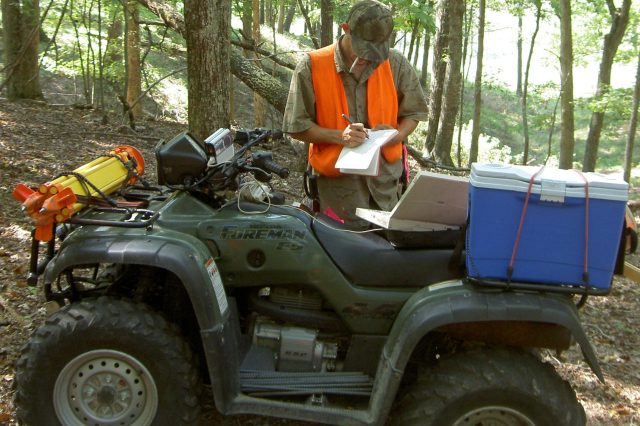
END CHAPTER SEVEN
-GET FACT UP WITH THE LOWER CAST, CATCH MORE FISH, EAT & REPEAT-
-LAND & MAN IS KNOWN BY THE DEEDS. SO SMOKE MORE THE WEEEDS.-
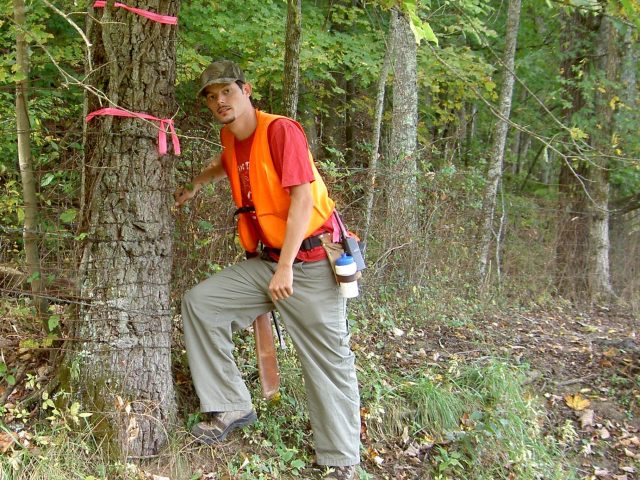
Writing and photography by D.S. Yona Anzelmo, PLS, GTW Liberty News 2023.
@ LA FIN @ THE END @


wow! powerful stuff.
I guess the ghosts of misdeeds past really do come home to roost eventually. it is criminal what they have done to this land and its people.